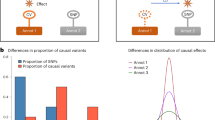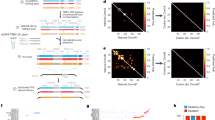Abstract
Here we report the first complete sequence and gene map of a human major histocompatibility complex (MHC), a region on chromosome 6 which is essential to the immune system (reviewed in ref. 1). When it was discovered over 50 years ago the region was thought to specify histocompatibility genes, but their nature has been resolved only in the last two decades. Although many of the 224 identified gene loci (128 predicted to be expressed) are still of unknown function, we estimate that about 40% of the expressed genes have immune system function. Over 50% of the MHC has been sequenced twice, in different haplotypes, giving insight into the extraordinary polymorphism and evolution of this region. Several genes, particularly of the MHC class II and III regions, can be traced by sequence similarity and synteny to over 700 million years ago, clearly predating the emergence of the adaptive immune system some 400 million years ago. The sequence is expected to be invaluable for the identification of many common disease loci. In the past, the search for these loci has been hampered by the complexity of high gene density and linkage disequilibrium.
This is a preview of subscription content, access via your institution
Access options
Subscribe to this journal
Receive 51 print issues and online access
$199.00 per year
only $3.90 per issue
Buy this article
- Purchase on Springer Link
- Instant access to full article PDF
Prices may be subject to local taxes which are calculated during checkout

Similar content being viewed by others
References
Klein,J. Natural History of the Major Histocompatibility Complex (Wiley, New York, 1986).
Tiwari,J. L. & Terasaki,P. I. HLA and Disease Associations (Springer, Berlin, 1985).
://www.sanger.ac.uk/HGP/Chr6/MHC.shtml
Dawkins,R. et al. Genomics of the major histocompatibility complex: haplotypes, duplication, retroviruses and disease. Immunol. Rev. 167, 275–304 (1999).
Limm,T. M., Ashdown,M. L., Naughton,M. J., McGinnis,M. D. & Simons M. D. HLA-DQA1 allele and suballele typing using non-coding sequence polymorphisms. Hum. Immunol. 38, 57–68 (1993).
Horton,R. et al. Large-scale sequence comparisons reveal unusually high levels of variation in the HLA-DQB1 locus in the class II region of the human MHC. J. Mol. Biol. 282, 71–97 (1998).
Guillaudeux,T., Janer,M., Wong,G. K., Spies,T. & Geraghty,D. E. The complete genomic sequence of 424,015 bp at the centromeric end of the HLA class I region: gene content and polymorphism. Proc. Natl Acad. Sci. USA 95, 9494–9499 (1998).
Satta,Y., Kupfermann,H., Li, Y.-J. & Takahata,N. Molecular clock and recombination in primate MHC genes. Immunol. Rev. 167, 367–379 (1999).
Trachtulec,Z. et al. Linkage of TATA-binding protein and proteasome subunit C5 genes in mice and humans reveals synteny conserved between mammals and invertebrates. Genomics 44, 1–7 (1997).
Fukagawa,T. et al. A boundary of long-range G+C% mosaic domains in the human MHC locus: pseudoautosomal boundary-like sequence exists near the boundary. Genomics 25, 184–191 (1995).
Stephens,R. et al. Gene organisation, sequence variation and isochore structure at the centromeric boundary of the human MHC. J. Mol. Biol. 291, 789–799 (1999).
Tenzen,T. et al. Precise switching of DNA replication timing in the GC content transition area in the human MHC. Mol. Cell. Biol. 17, 4043–4050 (1997).
Hamlin,J. L. & Dijkwel,P. A. On the nature of replication origins in higher eukaryotes. Curr. Opin. Genet. Dev. 5, 153–161 (1995).
Delgado,S., Gomez,M., Bird,A. & Antequera,F. Initiation of DNA replication at CpG islands in mammalian chromosomes. EMBO J. 17, 2426–2435 (1998).
Trowsdale,J. & Campbell,R. D. Map of the human major histocompatibility complex. Immunol. Today 18 (Suppl.) (1997).
Ruddy,D. A. et al. A 1.1-Mb transcript map of the hereditary hemochromatosis locus. Genome Res. 7, 441–456 (1997).
Gruen,J. R. & Weissman,S. M. Evolving views of the major histocompatibility complex. Blood 90, 4252–4256 (1997).
Bodmer,W. F. Evolutionary significance of the HLA system. Nature 237, 139–145 (1997).
Haino,M. et al. Comparison and evolution of human immunoglobulin VH segments located in the 3′ 0.8-megabase region: Evidence for unidirectional transfer of segmental gene sequences. J. Biol. Chem. 269, 2619–2626 (1994).
Sugaya,K. et al. Three genes in the human MHC class III region near the junction with the class II: Gene for receptor of advanced glycosylation end products, PBX homeobox genes and a Notch homolog, human counterpart of mouse mammary tumor gene int-3. Genomics 23, 408–419 (1994).
Kasahara,M. The chromosomal duplication model of the major histocompatibility complex. Immunol. Rev. 167, 17–32 (1999).
Kaufman,J. et al. The chicken B locus is a minimal essential major histocompatibility complex. Nature (this issue).
Acknowledgements
Sequencing of the class I region in the US was funded by a Department of Energy grant to M. Olson and by US NIH grants to D.G. Sequencing of the class I region in Japan was funded by the Japanese Science and Technology Corporation (JST). Sequencing of the class II region at the Sanger Centre was funded by the Wellcome Trust. Early stages of the class II sequence were funded by the Imperial Cancer Research Fund and the EU BioMed1 programme. Sequencing of the class III region at the University of Washington Multimegabase Sequencing Center was funded by the US NIH and Department of Energy. We thank all members past and present of the University of Washington Genome Center (http://www.genome.washington.edu/uwgc/), the Genome Sequencing Group at Tokai University (http://www.alis.tokyo.jst.go.jp/HGS/top.html), the Chromosome 6 Project Group at the Sanger Centre (http://www.sanger.ac.uk/HGP/Chr6) and the University of Washington Multimegabase Sequencing Center (http:/chroma.mbt.washington.edu/msg_www/) for their contributions. R.D.C. was funded by the UK Medical Research Council and J.T. was funded by the Wellcome Trust. The work was divided as follows: The Sanger Centre, Hinxton, UK: HSET to TSBP, 1.2 Mb; Tokai University, Isehara, Japan: HSPA1B to P5-15, 2.2 Mb; Fred Hutchinson Cancer Research Center and the University of Washington Genome Center (UWGC), Seattle, USA: NFKBIL1 to HLA-F and beyond, 2.2 Mb; University of Washington Multimegabase Sequencing Center (UWMSC), Seattle, USA: NOTCH4 to LTA, 0.76 Mb. From these sequences a 3,673,800-base-long consensus was assembled covering P5-15 to HSET (http://www.sanger.ac.uk/HGP/Chr6/MHC_990719.fasta).
Author information
Consortia
Additional information
Corresponding authors representing the four sequencing centres: S. Beck (The Sanger Centre, Wellcome Trust Genome Campus, Hinxton CB10 1SA, UK); D. Geraghty (Fred Hutchinson Cancer Research Center, Seattle, Washington 98104, USA); H. Inoko (Tokai University School of Medicine, Department of Molecular Life Science, Bohseidai, Isehara, Kanagawa 259-11, Japan); and L. Rowen (University of Washington, Seattle, Washington 98195, USA). A full list of contributors appears at the end of the paper.
Correspondence and requests for materials should be addressed to D. Geraghty (e-mail: geraghty@fhcrc.org) or H. Inoko (e-mail: hinoko@is.icc.u-tokai.ac.jp) for the class I region, S. Beck (e-mail: beck@sanger.ac.uk) or J. Trowsdale (e-mail: jt233@mole.bio.cam.ac.uk) for the class II region and D. Campbell (e-mail: rcampbel@hgmp.mrc.ac.uk) or L. Rowen (e-mail: leerowen@u.washington.edu) for the class III region.
Contributors in alphabetical order (numbers in parentheses indicate addresses): B. Aguado (5), S. Bahram (7), S. Beck (1), R. D. Campbell (5), S. A. Forbes (6), D. Geraghty (2), T. Guillaudeux (2), L. Hood (4), R. Horton (1), H. Inoko (3), M. Janer (2), C. Jasoni (2), A. Madan (4), S. Milne (1), M. Neville (5), A. Oka (3), S. Qin (4), G. Ribas-Despuig (5), J. Rogers (1), L. Rowen (4), T. Shiina (3), T. Spies (2), G. Tamiya (3), H. Tashiro (8), J. Trowsdale (6), Q. Vu (2), L. Williams (2), M. Yamazaki (8) (1)The Sanger Centre, Wellcome Trust Genome Campus, Hinxton CB10 1SA, UK (2)Fred Hutchinson Cancer Research Center, Seattle, Washington 98104, USA (3)Tokai University School of Medicine, Department of Molecular Life Science, Bohseidai, Isehara, Kanagawa 259-11, Japan (4)University of Washington, Seattle, Washington 98195, USA (5)HGMP Resource Centre, Wellcome Trust Genome Campus, Hinxton CB10 1SB, UK (6)Cambridge University, Department of Pathology, Division of Immunology, Tennis Court Road, Cambridge CB2 1QP, UK (7)Centre de Recherche d'Immunologie et d'Hematologie, 4 Rue Kirschleger, 67085 Strasbourg, France (8)Bioscience Research Laboratory, Fujiya Co., Ltd., 228 Soya, Hadano, Kanagawa 257, Japan
Supplementary information
Rights and permissions
About this article
Cite this article
The MHC sequencing consortium. Complete sequence and gene map of a human major histocompatibility complex. Nature 401, 921–923 (1999). https://doi.org/10.1038/44853
Received:
Accepted:
Issue Date:
DOI: https://doi.org/10.1038/44853
This article is cited by
-
Integrative HLA typing of tumor and adjacent normal tissue can reveal insights into the tumor immune response
BMC Medical Genomics (2024)
-
Benchmark of tools for in silico prediction of MHC class I and class II genotypes from NGS data
BMC Genomics (2023)
-
Knock-in mice expressing a humanized arachidonic acid 15-lipoxygenase (Alox15) carry a partly dysfunctional erythropoietic system
Cellular & Molecular Biology Letters (2023)
-
Emerging phagocytosis checkpoints in cancer immunotherapy
Signal Transduction and Targeted Therapy (2023)
-
CRISPR-based targeted haplotype-resolved assembly of a megabase region
Nature Communications (2023)
Comments
By submitting a comment you agree to abide by our Terms and Community Guidelines. If you find something abusive or that does not comply with our terms or guidelines please flag it as inappropriate.



